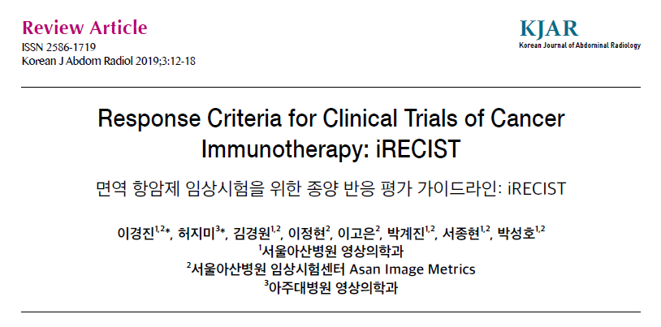Academic Share
Central Imaging Core Lab
1. Background for trial imaging for cancer
During the last two decades, imaging in drug development has been greatly advanced in a diversity of
therapeutic fields, especially in the oncology field. As regulatory agencies seek robust evidence for
primary endpoints, as much as possible, medical imaging usage is rapidly increased to support the
primary endpoints in clinical trials.
The addition of medical imaging in the clinical trials requires logistical and technical considerations, as
follows: (1) selection of appropriate qualified imaging biomarker, (2) standardization of imaging
acquisition, archive, and analysis, (3) independent blinded image review, and (4) system for complex
workflow and regulatory compliance.
In 2018, US FDA issued “Clinical Trial Imaging Endpoint Process Standards Guidance for Industry” so that
pharmaceutical companies, imaging scientists, and clinical trial professionals can utilize imaging in a
clinical trial as an appropriate manner.
2. Imaging Criteria for Cancer Trials
In the clinical trial of oncology, the RECIST 1.1 is the most widely used as qualified biomarkers based on
anatomical medical imaging, is adapted as a primary endpoint by the FDA (21). Nevertheless, RECIST 1.1
has its own limitation in treatment response assessment, specifically in the brain tumor, lymphoma,
and bone lesions. The NCI’s Cancer Imaging Program, therefore, allows to utilize other various
imaging response criteria as summarized in Table 1.
In the era of immunotherapy for cancer treatment, the number of clinical trials for cancer
immunotherapeutic agents has been rapidly increasing.
In 2017, the RECIST Working Group released a consensus guideline "iRECIST" for internationally
standardized response assessment in multicenter trial. The iRECIST was developed based on RECIST 1.1,
additionally introducing new terminologies and criteria. Accordingly, iRECIST is good for standardized
response assessments but also requires cautions to follow.
| Table 1. Imaging Response Criteria commonly used in cancer clinical trials | |
|---|---|
| Imaging Response Criteria | Comments |
| For [18F]FDG-PET scan | |
| European Organization for Research and Treatment of Cancer (EORTC) | Published in 1999, these set of recommendations are for measuring clinical and subclinical tumor response using FDG-PET scans |
| PET Response Criteria in Solid Tumors (PERCIST) | Published in 2009, PERCIST is a comprehensive set of response criteria for use with [18F]FDG-PET scans |
| For brain tumor | |
| McDonald Criteria | Published in 1990 for use with contrast-enhanced CT and MRI scans of the head, response is based on changes in tumor size and interpreted in light of steroid use and neurologic findings |
| Response Assessment in Neuro-Oncology (RANO) | Published in 2010, RANO is an update to the McDonald Criteria which also takes into consideration enhancing components of the tumor and non-contrast CT/MRI findings seen on the T2-weighted and FLAIR sequences. |
| RANO-Brain Metastases | Published in 2015, RANO-BM was developed by the RANO-BM Working Group as a standard response and progression criteria for use in clinical trials dealing with metastatic lesions to the brain. |
| RANO-Leptomeningeal metastases | Published in 2017, RANO-leptomeningeal metastases was developed by the RANO Working Group and they proposed three basic elements: a standardized neurological examination, cerebral spinal fluid (CSF) cytology or flow cytometry, and radiographic evaluation. |
| For lymphoma | |
| International Working Group (Cheson) Criteria | Published in 2007, the Cheson criteria defines standardized response criteria for Hodgkin’s and non-Hodgkin’s lymphoma using [18F]FDG PET, immunohistochemistry, and flow cytometry. |
| Deauville Criteria | Published in 2009, Deauville Criteria describes a simplified 5 point scale to standardize interpretation of FDG-PET for lymphoma |
| Lugano Recommendations | Published in 2014 as a result of a workshop at the 12th International Conference on Malignant Lymphoma, the Lugano Recommendations represent a set of revised recommendations regarding the use of the Cheson and Deauville Criteria and formally incorporated [18F]FDG PET into standard staging and response evaluation for FDG-avid lymphomas. |
| For bone lesions | |
| MD Anderson Bone Response Criteria (MDA) | Published in 2004, the MDA defines response in bone lesions based on anatomic imaging such as XR, CT, and MRI |
| Prostate Cancer Working Group 2 (PCWG2) | Published in 2008, PCWG2 defines progression by imaging in prostate cancer but does not provide standardized definitions for treatment response by imaging |
| For immunotherapy | |
| iRECIST | Published in 2017, revised from the RECIST 1.1 for immunotherapy in solid tumor patients. |
| iRANO | Published in 2015, revised from the RANO for immunotherapy in brain tumor patients. |
| LYRIC | Published in 2016, revised from the Lugano criteria for immunomodulatory therapy in lymphoma patients. |
| Imaging response criteria are listed in the NCI’s Cancer Imaging Program (assessed at https://imaging.cancer.gov/clinical_trials/imaging_response_criteria.htm ) | |
뇌종양 임상 시험에서 RANO 및 RANO 수행 방법
임상시험에 주요 활용되는 영상기법
소개(CT, MRI, PET)
고형암 임상시험에서 RECIST 1.1과 iRECIST 수행방법
